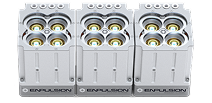Ion-induced Electron Emission by keV-range Energy Indium Ions: Influence of Material and Geometry
Abstract:
This work provides measurements of the ion-induced electron emission (SEE) yield caused by keV-range energy indium ions (3 to 8 keV). In our experiment the ion sources, fuelled with indium, are based on the working principle of field-emission electric propulsion (FEEP) technologies. The measured yields are given for different material properties (plain structure vs foam) and geometries (flat surface vs conical). Study outcomes show that electrons induced by keV-range indium ions can lead to overestimate the measured ion current by 30% to 200% depending on the collector materials and geometry. We spotlighted that molybdenum, tungsten and stainless steel 316L have relatively low yields compared to aluminium 2017A. Moreover, it is possible to lower down a specific material yield by two third when using a foam structure. Finally, it is shown that off-axis ions influence on a collector increase the resulting electron emission yield. In the case of an indium-FEEP thruster ion-induced electron emissions are a major perturbation when measuring ion current. Mainly due to the energy range of ions studied, yields retrieved are orders of magnitudes larger than what it is usually measured when studying the plume of an electrostatic electric propulsion system. It is therefore strongly recommended to use a so-called Faraday cup to study the ion beam from an indium-FEEP thruster as the probe close architecture allows to greatly mitigate these perturbations.



